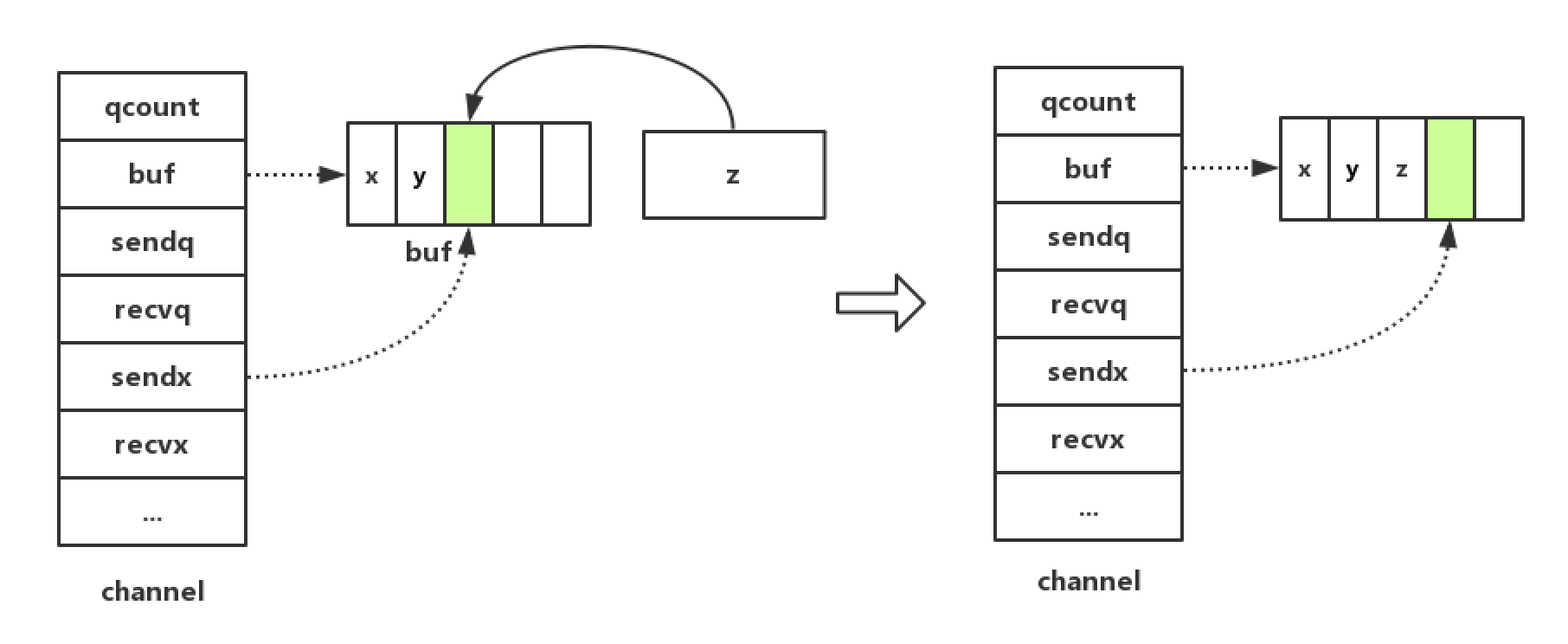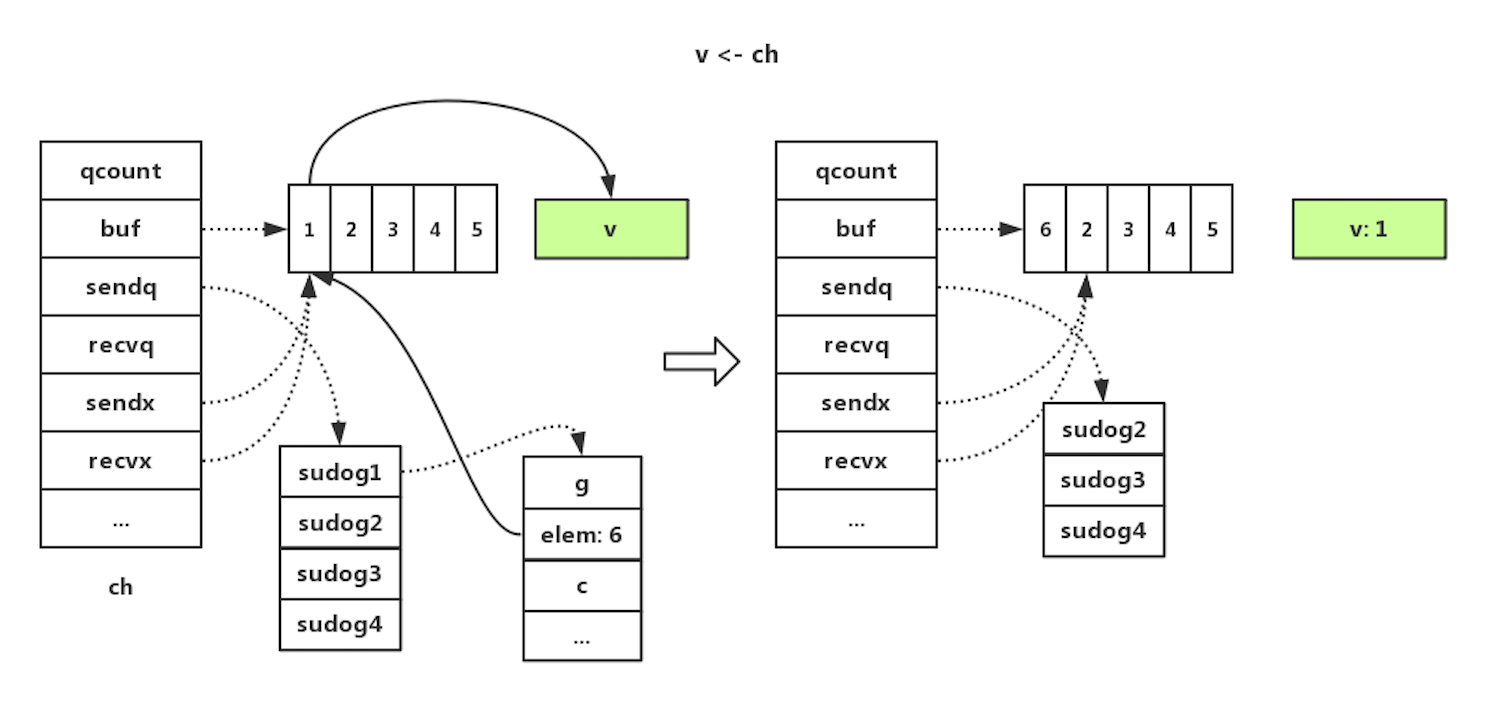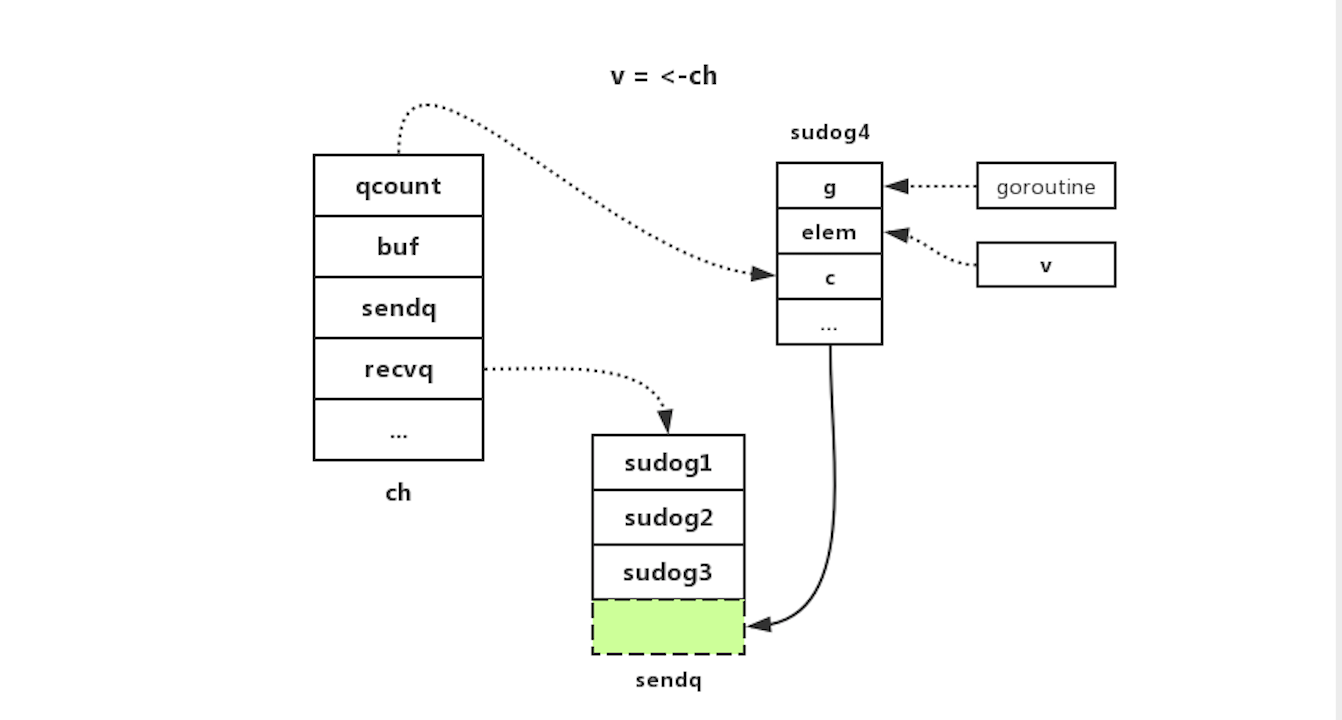严正声明,部分摘自:深入理解Golang之channel - 掘金,仅做个人备份,浏览请看原文
目录
2.3、unbuffered channels 与 buffered channels
1、前言
Golang在并发编程上有两大利器分别是channel和goroutine,Go语言在sync包中提供了传统的锁机制,但更推荐使用channel来解决并发问题。
Channel常常结合go select使用,select思想来源于网络IO模型中的select,本质上也是IO多路复用,只不过这里的IO是基于channel而不是基于网络,同时go select也有一些自己不同的特性:
- 每个case都必须是一个通信
- 所有channel表达式都会被求值
- 所有被发送的表达式都会被求值
- 如果任意某个通信可以进行,它就执行;其他被忽略。
- 如果有多个case都可以运行,select会伪随机选出一个执行。其他不会执行。否则执行default子句(如果有)
- 如果没有default字句,select将阻塞,直到某个通信可以运行;Go不会重新对channel或值进行求值。
2、channel概述
2.1、## 用法
func main() {
ch := make(chan int, 1) // 创建一个类型为int,缓冲区大小为1的channel
ch <- 2 // 将2发送到ch
n, ok := <- ch // n接收从ch发出的值
if ok {
fmt.Println(n) // 2
}
close(ch) // 关闭channel
}2.2、## 几个注意点
- channel关闭后不可以继续向channel发送消息(向一个已经关闭的channel发送消息,会引发运行时恐慌(panic));但可以继续从channel接收消息,当channel关闭并且缓冲区为空时,继续从从channel接收消息会得到一个对应类型的零值。
- 向一个nil channel发送消息,会一直阻塞。
2.3、unbuffered channels 与 buffered channels
【unbuffered channels】是指缓冲区大小为0的channel,这种channel的接收者会阻塞直至接收到消息,发送者会阻塞直至接收者接收到消息,这种机制可以用于两个goroutine进行状态同步。
【buffered channels】拥有缓冲区,当缓冲区已满时,发送者会阻塞;当缓冲区为空时,接收者会阻塞。
2.4、channel的遍历
2.4.1、## for range
channel支持 for range 的方式进行遍历。
在遍历时,如果channel 没有关闭,那么会一直等待下去。
如果在遍历时channel已经关闭,那么在遍历完数据后自动退出遍历。
func main() {
ci := make(chan int, 5)
for i := 1; i <= 5; i++ {
ci <- i
}
close(ci)
for i := range ci {
fmt.Println(i)
}
} 2.4.2、## for select
select中有case代码块,用于channel发送或接收消息。
任意一个case代码块准备好时,执行其对应内容;多个case代码块准备好时,随机选择一个case代码块并执行;
所有case代码块都没有准备好,则等待;
还可以有一个default代码块,所有case代码块都没有准备好时执行default代码块。
func main() {
ci := make(chan int, 2)
for i := 1; i <= 2; i++ {
ci <- i
}
close(ci)
cs := make(chan string, 2)
cs <- "hi"
cs <- "golang"
close(cs)
ciClosed, csClosed := false, false
for {
if ciClosed && csClosed {
return
}
select {
case i, ok := <-ci:
if ok {
fmt.Println(i)
} else {
ciClosed = true
fmt.Println("ci closed")
}
case s, ok := <-cs:
if ok {
fmt.Println(s)
} else {
csClosed = true
fmt.Println("cs closed")
}
default:
fmt.Println("waiting...")
}
}
} 3、channel原理
源码地址:go/chan.go at master · golang/go · GitHub
包路径:/runtime/chan.go
3.1、## 数据结构
首先概述,channel的缓冲区其实是一个环形队列:
qcount 表示队列中元素的数量。
dataqsiz 表示环形队列的总大小。
buf 表示一个指向循环数组的指针,sendx、recvx 分别用来标识当前发送和接收的元素在循环数组中的位置。
recvq、sendq 是2个列表,分别用于存储当前处于等待接收和等待发送的Goroutine。即:一个是存往这个chan里写数据而卡死(等待)的协程,一个是存从这个chan里取数据而卡死(等待)的协程。后续在对此chan进行发送和接受时,会有机会唤醒卡在recvq、sendq里的协程。
看channel的结构体:
type hchan struct {
qcount uint // total data in the queue
dataqsiz uint // size of the circular queue
buf unsafe.Pointer // points to an array of dataqsiz elements
elemsize uint16 // channel元素大小
closed uint32 // 是否已经关闭
elemtype *_type // element type channel中元素的类型
sendx uint // send index
recvx uint // receive index
recvq waitq // list of recv waiters
sendq waitq // list of send waiters
lock mutex
}再看一下waitq的数据结构:
type waitq struct {
first *sudog
last *sudog
}
// 以下是sudog结构体,包路径为:/runtime/runtime2.go
type sudog struct {
// 当前goroutine
g *g
// isSelect indicates g is participating in a select, so
// g.selectDone must be CAS'd to win the wake-up race.
isSelect bool
next *sudog
prev *sudog
elem unsafe.Pointer // data element (may point to stack)
// The following fields are never accessed concurrently.
// For channels, waitlink is only accessed by g.
// For semaphores, all fields (including the ones above)
// are only accessed when holding a semaRoot lock.
acquiretime int64
releasetime int64
ticket uint32
parent *sudog // semaRoot binary tree
waitlink *sudog // g.waiting list or semaRoot
waittail *sudog // semaRoot
c *hchan // channel
}其中sudog表示处于等待列表中的Goroutine封装,包含了一些上下文信息,first和last分别指向等待列表的首位的Goroutine。
3.2、编译分析
在分析channel的原理之前,我们先使用go tool分析以下代码,看看channel的各种操作在底层调用了什么运行时方法:
ch := make(chan int, 2)
ch <- 2
ch <- 1
<-ch
n, ok := <-ch
if ok {
fmt.Println(n)
}
close(ch)编译:
go build test.go
go tool objdump -s "main\.main" test | grep CALL把CALL过滤出来:
3.3、创建
从上面的编译分析可以看出在创建channel时调用了运行时方法makechan:
func makechan(t *chantype, size int) *hchan {
elem := t.elem
// compiler checks this but be safe.
if elem.size >= 1<<16 {
throw("makechan: invalid channel element type")
}
if hchanSize%maxAlign != 0 || elem.align > maxAlign {
throw("makechan: bad alignment")
}
// 计算缓冲区需要的总大小(缓冲区大小*元素大小),并判断是否超出最大可分配范围
mem, overflow := math.MulUintptr(elem.size, uintptr(size))
if overflow || mem > maxAlloc-hchanSize || size < 0 {
panic(plainError("makechan: size out of range"))
}
// Hchan does not contain pointers interesting for GC when elements stored in buf do not contain pointers.
// buf points into the same allocation, elemtype is persistent.
// SudoG's are referenced from their owning thread so they can't be collected.
// TODO(dvyukov,rlh): Rethink when collector can move allocated objects.
var c *hchan
switch {
case mem == 0:
// 缓冲区大小为0,或者channel中元素大小为0(struct{}{})时,只需分配channel必需的空间即可
// Queue or element size is zero.
c = (*hchan)(mallocgc(hchanSize, nil, true))
// Race detector uses this location for synchronization.
c.buf = c.raceaddr()
case elem.ptrdata == 0:
// 通过位运算知道channel中元素类型不是指针,分配一片连续内存空间,所需空间等于 缓冲区数组空间 + hchan必需的空间。
// Elements do not contain pointers.
// Allocate hchan and buf in one call.
c = (*hchan)(mallocgc(hchanSize+mem, nil, true))
c.buf = add(unsafe.Pointer(c), hchanSize)
default:
// 元素中包含指针,为hchan和缓冲区分别分配空间
// Elements contain pointers.
c = new(hchan)
c.buf = mallocgc(mem, elem, true)
}
c.elemsize = uint16(elem.size)
c.elemtype = elem
c.dataqsiz = uint(size)
if debugChan {
print("makechan: chan=", c, "; elemsize=", elem.size, "; dataqsiz=", size, "\n")
}
return c
}makechan的代码逻辑还是比较简单的,首先校验元素类型和缓冲区空间大小,然后创建hchan,分配所需空间。这里有三种情况:当缓冲区大小为0,或者channel中元素大小为0时,只需分配channel必需的空间即可;当channel元素类型不是指针时,则只需要为hchan和缓冲区分配一片连续内存空间,空间大小为缓冲区数组空间加上hchan必需的空间;默认情况,缓冲区包含指针,则需要为hchan和缓冲区分别分配内存。最后更新hchan的其他字段,包括elemsize,elemtype,dataqsiz。
3.4、发送
channel的发送操作调用了运行时方法chansend1, 在chansend1内部又调用了chansend,直接来看chansend的实现:
func chansend(c *hchan, ep unsafe.Pointer, block bool, callerpc uintptr) bool {
// channel为nil
if c == nil {
// 如果是非阻塞,直接返回发送不成功
if !block {
return false
}
// 否则,当前Goroutine阻塞挂起
gopark(nil, nil, waitReasonChanSendNilChan, traceEvGoStop, 2)
throw("unreachable")
}
if debugChan {
print("chansend: chan=", c, "\n")
}
if raceenabled {
racereadpc(c.raceaddr(), callerpc, funcPC(chansend))
}
// Fast path: check for failed non-blocking operation without acquiring the lock.
//
// After observing that the channel is not closed, we observe that the channel is
// not ready for sending. Each of these observations is a single word-sized read
// (first c.closed and second c.recvq.first or c.qcount depending on kind of channel).
// Because a closed channel cannot transition from 'ready for sending' to
// 'not ready for sending', even if the channel is closed between the two observations,
// they imply a moment between the two when the channel was both not yet closed
// and not ready for sending. We behave as if we observed the channel at that moment,
// and report that the send cannot proceed.
//
// It is okay if the reads are reordered here: if we observe that the channel is not
// ready for sending and then observe that it is not closed, that implies that the
// channel wasn't closed during the first observation.
// 对于非阻塞且channel未关闭,如果无缓冲区且没有等待接收的Goroutine,或者有缓冲区且缓冲区已满,那么都直接返回发送不成功
if !block && c.closed == 0 && ((c.dataqsiz == 0 && c.recvq.first == nil) ||
(c.dataqsiz > 0 && c.qcount == c.dataqsiz)) {
return false
}
var t0 int64
if blockprofilerate > 0 {
t0 = cputicks()
}
// 加锁
lock(&c.lock)
// 如果channel已关闭
if c.closed != 0 {
// 解锁,直接panic
unlock(&c.lock)
panic(plainError("send on closed channel"))
}
// 除了以上情况,当channel未关闭时,就有以下几种情况:
// 1、当存在等待接收的Goroutine
if sg := c.recvq.dequeue(); sg != nil {
// Found a waiting receiver. We pass the value we want to send
// directly to the receiver, bypassing the channel buffer (if any).
// 那么直接把正在发送的值发送给等待接收的Goroutine
send(c, sg, ep, func() { unlock(&c.lock) }, 3)
return true
}
// 2、当缓冲区未满时
if c.qcount < c.dataqsiz {
// Space is available in the channel buffer. Enqueue the element to send.
// 获取指向缓冲区数组中位于sendx位置的元素的指针
qp := chanbuf(c, c.sendx)
if raceenabled {
raceacquire(qp)
racerelease(qp)
}
// 将当前发送的值拷贝到缓冲区
typedmemmove(c.elemtype, qp, ep)
// sendx索引长度+
c.sendx++
// 因为是循环队列,sendx等于队列长度时置为0
if c.sendx == c.dataqsiz {
c.sendx = 0
}
// 队列中元素总数加一,并解锁,返回发送成功
c.qcount++
unlock(&c.lock)
return true
}
// 3、当既没有等待接收的Goroutine,缓冲区也没有剩余空间,如果是非阻塞的发送,那么直接解锁,返回发送失败
if !block {
unlock(&c.lock)
return false
}
// Block on the channel. Some receiver will complete our operation for us.
// 4、如果是阻塞发送,那么就将当前的Goroutine打包成一个sudog结构体,并加入到channel的发送队列sendq里
gp := getg()
mysg := acquireSudog()
mysg.releasetime = 0
if t0 != 0 {
mysg.releasetime = -1
}
// No stack splits between assigning elem and enqueuing mysg
// on gp.waiting where copystack can find it.
mysg.elem = ep
mysg.waitlink = nil
mysg.g = gp
mysg.isSelect = false
mysg.c = c
gp.waiting = mysg
gp.param = nil
c.sendq.enqueue(mysg)
// 调用goparkunlock将当前Goroutine设置为等待状态并解锁,进入休眠等待被唤醒
gopark(chanparkcommit, unsafe.Pointer(&c.lock), waitReasonChanSend, traceEvGoBlockSend, 2)
// Ensure the value being sent is kept alive until the
// receiver copies it out. The sudog has a pointer to the
// stack object, but sudogs aren't considered as roots of the
// stack tracer.
KeepAlive(ep)
// someone woke us up.
// 被唤醒之后执行清理工作并释放sudog结构体
if mysg != gp.waiting {
throw("G waiting list is corrupted")
}
gp.waiting = nil
gp.activeStackChans = false
if gp.param == nil {
if c.closed == 0 {
throw("chansend: spurious wakeup")
}
panic(plainError("send on closed channel"))
}
gp.param = nil
if mysg.releasetime > 0 {
blockevent(mysg.releasetime-t0, 2)
}
mysg.c = nil
releaseSudog(mysg)
return true
}chansend的执行逻辑,上面的注释已经写得很清楚了,我们再来梳理一下。对于非阻塞发送或者channel已经关闭条件下的几种发送失败的情况,处理逻辑比较简单,读者可以对照注释来看;这里我们重点关注channel未关闭时几种常规情况:
3.4.1、## 存在等待接收的Goroutine
如果等待接收的队列recvq中存在Goroutine,那么直接把正在发送的值发送给等待接收的Goroutine,(对应recvq和sendq)。示意图如下:

具体看一下send方法:
func send(c *hchan, sg *sudog, ep unsafe.Pointer, unlockf func(), skip int) {
...
if sg.elem != nil {
// 将发送的值直接拷贝到接收值(比如v = <-ch 中的v)的内存地址
sendDirect(c.elemtype, sg, ep)
sg.elem = nil
}
// 获取等待接收数据的Goroutine
gp := sg.g
unlockf()
gp.param = unsafe.Pointer(sg)
if sg.releasetime != 0 {
sg.releasetime = cputicks()
}
// 唤醒之前等待接收数据的Goroutine
goready(gp, skip+1)
}这里有必要说明一下Goroutine在调度过程中的几种状态:
- _Gidle = iota // goroutine刚刚分配,还没有初始化
- _Grunnable // goroutine处于运行队列中, 还没有运行,没有自己的栈
- _Grunning // goroutine在运行中,拥有自己的栈,被分配了M(线程)和P(调度上下文)
- _Gsyscall // goroutine在执行系统调用
- _Gwaiting // goroutine被阻塞
- _Gdead // goroutine没有被使用,可能是刚刚退出,或者正在初始化中
- _Gcopystack // 表示g当前的栈正在被移除并分配新栈
当调用goready时,将Goroutine的状态从 _Gwaiting置为_Grunnable,等待下一次调度再次执行。
3.4.2、## 当缓冲区未满时
当缓冲区未满时,找到sendx所指向的缓冲区数组的位置,将正在发送的值拷贝到该位置,并增加sendx索引以及释放锁,示意图如下:

3.4.3、## 阻塞发送
如果是阻塞发送,那么就将当前的Goroutine打包成一个sudog结构体,并加入到channel的发送队列sendq里。示意图如下:

之后则调用goparkunlock将当前Goroutine设置为_Gwaiting状态并解锁,进入阻塞状态等待被唤醒(调用goready);如果被调度器唤醒,执行清理工作并最终释放对应的sudog结构体。
3.5、接收
channel的接收有两种形式:
<-ch
n, ok := <-ch这两种方式分别调用运行时方法chanrecv1和chanrecv2:
// entry points for <- c from compiled code
//go:nosplit
func chanrecv1(c *hchan, elem unsafe.Pointer) {
chanrecv(c, elem, true)
}
//go:nosplit
func chanrecv2(c *hchan, elem unsafe.Pointer) (received bool) {
_, received = chanrecv(c, elem, true)
return
}这两个方法最终都会调用chanrecv方法:
func chanrecv(c *hchan, ep unsafe.Pointer, block bool) (selected, received bool) {
// raceenabled: don't need to check ep, as it is always on the stack
// or is new memory allocated by reflect.
if debugChan {
print("chanrecv: chan=", c, "\n")
}
// channel为nil
if c == nil {
// 非阻塞直接返回(false, false)
if !block {
return
}
// 阻塞接收,则当前Goroutine阻塞挂起
gopark(nil, nil, waitReasonChanReceiveNilChan, traceEvGoStop, 2)
throw("unreachable")
}
// Fast path: check for failed non-blocking operation without acquiring the lock.
// 非阻塞模式,对于以下两种情况:
// 1、无缓冲区且等待发送队列也为空
// 2、有缓冲区但缓冲区数组为空且channel未关闭
// 这两种情况都是接收失败, 直接返回(false, false)
if !block && (c.dataqsiz == 0 && c.sendq.first == nil ||
c.dataqsiz > 0 && atomic.Loaduint(&c.qcount) == 0) &&
atomic.Load(&c.closed) == 0 {
return
}
var t0 int64
if blockprofilerate > 0 {
t0 = cputicks()
}
// 加锁
lock(&c.lock)
// 如果channel已关闭,并且缓冲区无元素
if c.closed != 0 && c.qcount == 0 {
if raceenabled {
raceacquire(c.raceaddr())
}
unlock(&c.lock)
// 有等待接收的变量(即 v = <-ch中的v)
if ep != nil {
//根据channel元素的类型清理ep对应地址的内存,即ep接收了channel元素类型的零值
typedmemclr(c.elemtype, ep)
}
// 返回(true, false),即接收到值,但不是从channel中接收的有效值
return true, false
}
// 除了以上非常规情况,还有有以下几种常见情况
// 1、等待发送的队列sendq里存在Goroutine,那么有两种情况:当前channel无缓冲区,或者当前channel已满
if sg := c.sendq.dequeue(); sg != nil {
// Found a waiting sender. If buffer is size 0, receive value
// directly from sender. Otherwise, receive from head of queue
// and add sender's value to the tail of the queue (both map to
// the same buffer slot because the queue is full).
// 如果无缓冲区,那么直接从sender接收数据;否则,从buf队列的头部接收数据,并把sender的数据加到buf队列的尾部
recv(c, sg, ep, func() { unlock(&c.lock) }, 3)
// 接收成功
return true, true
}
// 2、缓冲区buf中有元素
if c.qcount > 0 {
// Receive directly from queue
// 从recvx指向的位置获取元素
qp := chanbuf(c, c.recvx)
if raceenabled {
raceacquire(qp)
racerelease(qp)
}
if ep != nil {
// 将从buf中取出的元素拷贝到当前协程
typedmemmove(c.elemtype, ep, qp)
}
// 同时将取出的数据所在的内存清空
typedmemclr(c.elemtype, qp)
// 接收索引++
c.recvx++
if c.recvx == c.dataqsiz {
c.recvx = 0
}
// buf元素总数 -1
c.qcount--
// 解锁,返回接收成功
unlock(&c.lock)
return true, true
}
// 3、非阻塞模式,且没有数据可以接受
if !block {
// 解锁,直接返回接收失败
unlock(&c.lock)
return false, false
}
// no sender available: block on this channel.
// 4、阻塞模式,获取当前Goroutine,打包一个sudog
gp := getg()
mysg := acquireSudog()
mysg.releasetime = 0
if t0 != 0 {
mysg.releasetime = -1
}
// No stack splits between assigning elem and enqueuing mysg
// on gp.waiting where copystack can find it.
mysg.elem = ep
mysg.waitlink = nil
gp.waiting = mysg
mysg.g = gp
mysg.isSelect = false
mysg.c = c
gp.param = nil
// 加入到channel的等待接收队列recvq中
c.recvq.enqueue(mysg)
// 挂起当前Goroutine,设置为_Gwaiting状态并解锁,进入休眠等待被唤醒
gopark(chanparkcommit, unsafe.Pointer(&c.lock), waitReasonChanReceive, traceEvGoBlockRecv, 2)
// someone woke us up
// 被唤醒之后执行清理工作并释放sudog结构体
if mysg != gp.waiting {
throw("G waiting list is corrupted")
}
gp.waiting = nil
gp.activeStackChans = false
if mysg.releasetime > 0 {
blockevent(mysg.releasetime-t0, 2)
}
closed := gp.param == nil
gp.param = nil
mysg.c = nil
releaseSudog(mysg)
return true, !closed
}chanrecv方法的处理逻辑与chansend非常类似,我们这里仍然只分析几种常见情况,其他情况上述注释也解释得比较清楚了,读者可对照相应代码和注释查看。
3.5.1、## 存在等待发送的Goroutine
如果等待发送的队列sendq里存在挂起的Goroutine,那么有两种情况:当前channel无缓冲区,或者当前channel已满。从sendq中取出最先阻塞的Goroutine,然后调用recv方法:
func recv(c *hchan, sg *sudog, ep unsafe.Pointer, unlockf func(), skip int) {
if c.dataqsiz == 0 {
// 无缓冲区
if raceenabled {
racesync(c, sg)
}
if ep != nil {
// copy data from sender
recvDirect(c.elemtype, sg, ep)
}
} else {
// 缓冲区已满
// Queue is full. Take the item at the
// head of the queue. Make the sender enqueue
// its item at the tail of the queue. Since the
// queue is full, those are both the same slot.
qp := chanbuf(c, c.recvx)
if raceenabled {
raceacquire(qp)
racerelease(qp)
raceacquireg(sg.g, qp)
racereleaseg(sg.g, qp)
}
// copy data from queue to receiver
if ep != nil {
typedmemmove(c.elemtype, ep, qp)
}
// copy data from sender to queue
typedmemmove(c.elemtype, qp, sg.elem)
c.recvx++
if c.recvx == c.dataqsiz {
c.recvx = 0
}
c.sendx = c.recvx // c.sendx = (c.sendx+1) % c.dataqsiz
}
sg.elem = nil
gp := sg.g
unlockf()
gp.param = unsafe.Pointer(sg)
if sg.releasetime != 0 {
sg.releasetime = cputicks()
}
// 将等待发送数据的Goroutine的状态从_Gwaiting置为 _Grunnable,等待下一次调度
goready(gp, skip+1)
}1、如果无缓冲区,那么直接从sender接收数据;
2、如果缓冲区已满,从buf队列的头部接收数据,并把sender的数据加到buf队列的尾部;
3、最后调用goready函数将等待发送数据的Goroutine的状态从_Gwaiting置为_Grunnable,等待下一次调度。
下图示意了当缓冲区已满时的处理过程:

3.5.2、## 缓冲区buf中还有数据
如果缓冲区buf中还有元素,那么就走正常的接收,将从buf中取出的元素拷贝到当前协程的接收数据目标内存地址中。值得注意的是,即使此时channel已经关闭,仍然可以正常地从缓冲区buf中接收数据。这种情况比较简单,示意图就不画了。
3.5.3、## 阻塞接收
如果是阻塞模式,且当前没有数据可以接收,那么就需要将当前Goroutine打包成一个sudog加入到channel的等待接收队列recvq中,将当前Goroutine的状态置为_Gwaiting,等待唤醒。示意图如下:

如果之后当前Goroutine被调度器唤醒,则执行清理工作并最终释放对应的sudog结构体。
3.6、## 关闭
1、关闭channel时,会遍历recvq和sendq(实际只有recvq或者sendq),取出sudog中挂起的Goroutine加入到glist列表中,并清除sudog上的一些信息和状态。
2、然后遍历glist列表,为每个Goroutine调用goready函数,将所有Goroutine置为_Grunnable状态,等待调度。
3、当Goroutine被唤醒之后,会继续执行chansend和chanrecv函数中当前Goroutine被唤醒后的剩余逻辑。
func closechan(c *hchan) {
// nil channel检查
if c == nil {
panic(plainError("close of nil channel"))
}
lock(&c.lock)
// 已关闭的channel不能再次关闭
if c.closed != 0 {
unlock(&c.lock)
panic(plainError("close of closed channel"))
}
if raceenabled {
callerpc := getcallerpc()
racewritepc(c.raceaddr(), callerpc, funcPC(closechan))
racerelease(c.raceaddr())
}
// 设置关闭状态为1
c.closed = 1
var glist gList
// release all readers
// 遍历recvq,清除sudog的数据,取出其中处于_Gwaiting状态的Goroutine加入到glist中
for {
sg := c.recvq.dequeue()
if sg == nil {
break
}
if sg.elem != nil {
typedmemclr(c.elemtype, sg.elem)
sg.elem = nil
}
if sg.releasetime != 0 {
sg.releasetime = cputicks()
}
gp := sg.g
gp.param = nil
if raceenabled {
raceacquireg(gp, c.raceaddr())
}
glist.push(gp)
}
// release all writers (they will panic)
// 遍历sendq,清除sudog的数据,取出其中处于_Gwaiting状态的Goroutine加入到glist中
for {
sg := c.sendq.dequeue()
if sg == nil {
break
}
sg.elem = nil
if sg.releasetime != 0 {
sg.releasetime = cputicks()
}
gp := sg.g
gp.param = nil
if raceenabled {
raceacquireg(gp, c.raceaddr())
}
glist.push(gp)
}
unlock(&c.lock)
// Ready all Gs now that we've dropped the channel lock.
// 将glist中所有Goroutine的状态置为_Grunnable,等待调度器进行调度
for !glist.empty() {
gp := glist.pop()
gp.schedlink = 0
goready(gp, 3)
}
}





















 3万+
3万+











 被折叠的 条评论
为什么被折叠?
被折叠的 条评论
为什么被折叠?








